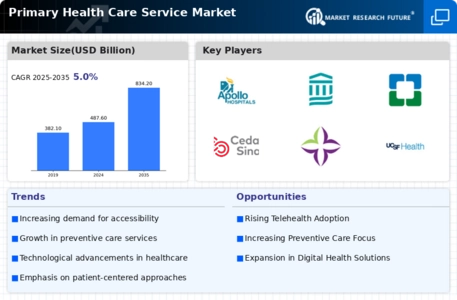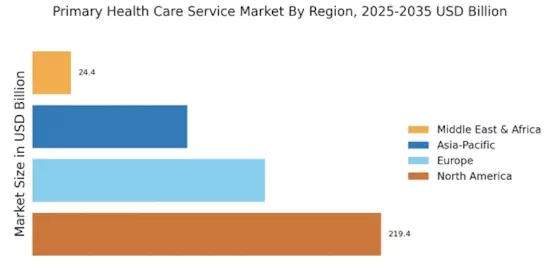North America : Healthcare Innovation Leader
North America is the largest market for primary health care services, accounting for approximately 45% of the global market share. The region's growth is driven by increasing healthcare expenditure, a rising aging population, and advancements in telehealth technologies. Regulatory support, such as the Affordable Care Act, has also catalyzed demand for accessible healthcare services, enhancing patient engagement and preventive care initiatives.
The United States is the leading country in this region, with major players like UnitedHealth Group, Anthem, and Kaiser Permanente dominating the landscape. The competitive environment is characterized by a mix of private and public providers, with a strong emphasis on integrated care models. Canada also plays a significant role, focusing on universal health coverage and innovative service delivery models, further solidifying North America's position in the primary health care market.
Europe : Evolving Healthcare Landscape
Europe is witnessing a significant transformation in its primary health care services, holding approximately 30% of the global market share. The region's growth is fueled by an increasing focus on preventive care, aging populations, and the integration of digital health solutions. Regulatory frameworks, such as the European Health Union initiative, aim to enhance healthcare accessibility and quality, driving demand for primary care services across member states.
Leading countries in Europe include Germany, France, and the UK, where key players like Fresenius SE & Co. KGaA and Ramsay Santé are making substantial contributions. The competitive landscape is marked by a mix of public and private providers, with an emphasis on patient-centered care. The European market is also characterized by collaborative efforts among countries to improve health outcomes and share best practices, positioning Europe as a dynamic player in the primary health care sector.
Asia-Pacific : Emerging Healthcare Powerhouse
Asia-Pacific is rapidly emerging as a significant player in the primary health care services market, accounting for approximately 20% of the global market share. The region's growth is driven by increasing urbanization, rising disposable incomes, and a growing emphasis on health and wellness. Governments are investing in healthcare infrastructure and implementing policies to enhance service delivery, which is further propelling market demand for primary care services.
Countries like China, India, and Japan are at the forefront of this growth, with a competitive landscape that includes both established healthcare providers and new entrants. Key players are focusing on expanding their service offerings and leveraging technology to improve patient care. The region's diverse healthcare needs and varying regulatory environments present both challenges and opportunities for market participants, making Asia-Pacific a dynamic and evolving market.
Middle East and Africa : Developing Healthcare Sector
The Middle East and Africa region is witnessing a gradual expansion in primary health care services, holding approximately 5% of the global market share. The growth is driven by increasing healthcare investments, a rising prevalence of chronic diseases, and government initiatives aimed at improving health outcomes. Regulatory frameworks are evolving to support the development of primary care services, enhancing access and quality for underserved populations.
Leading countries in this region include South Africa, UAE, and Saudi Arabia, where key players are focusing on expanding their healthcare networks. The competitive landscape is characterized by a mix of public and private providers, with an emphasis on improving service delivery and patient engagement. The region's unique challenges, such as resource constraints and varying health needs, present opportunities for innovative solutions in primary health care delivery.


















Leave a Comment